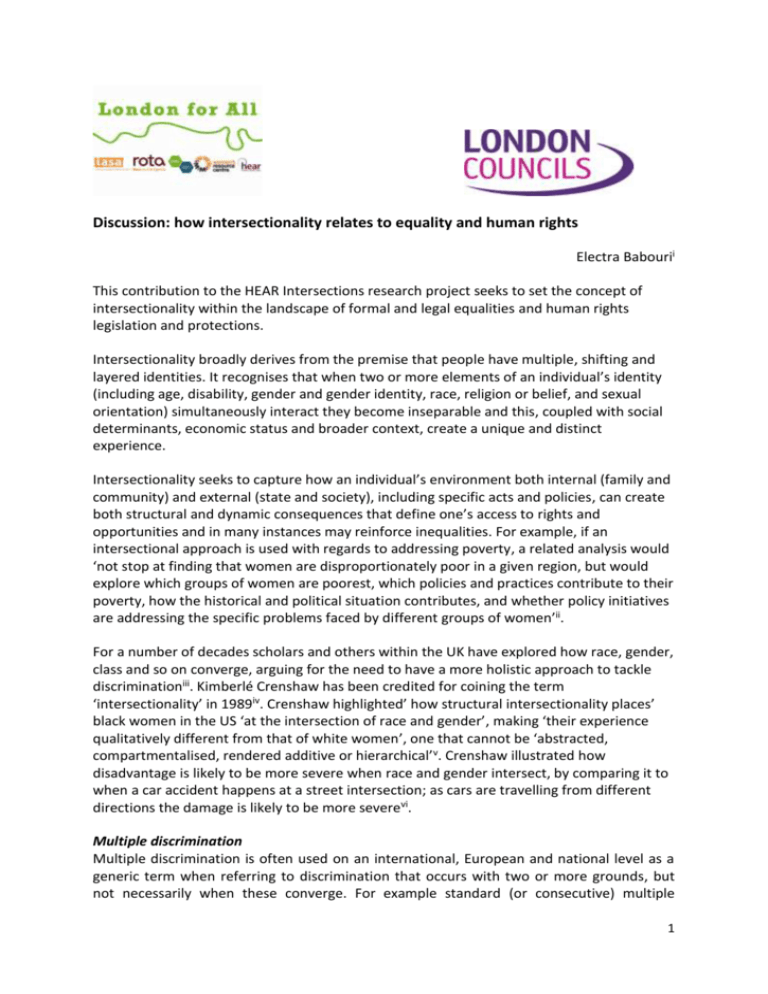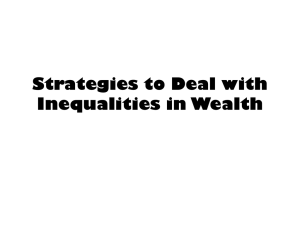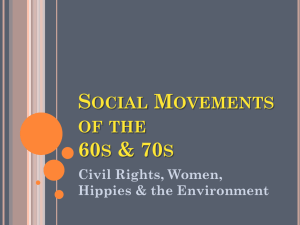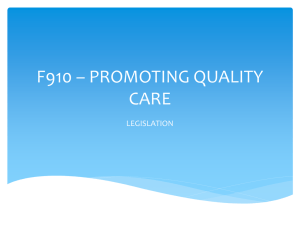Discussion: how intersectionality relates to equality and
advertisement

Discussion: how intersectionality relates to equality and human rights Electra Babourii This contribution to the HEAR Intersections research project seeks to set the concept of intersectionality within the landscape of formal and legal equalities and human rights legislation and protections. Intersectionality broadly derives from the premise that people have multiple, shifting and layered identities. It recognises that when two or more elements of an individual’s identity (including age, disability, gender and gender identity, race, religion or belief, and sexual orientation) simultaneously interact they become inseparable and this, coupled with social determinants, economic status and broader context, create a unique and distinct experience. Intersectionality seeks to capture how an individual’s environment both internal (family and community) and external (state and society), including specific acts and policies, can create both structural and dynamic consequences that define one’s access to rights and opportunities and in many instances may reinforce inequalities. For example, if an intersectional approach is used with regards to addressing poverty, a related analysis would ‘not stop at finding that women are disproportionately poor in a given region, but would explore which groups of women are poorest, which policies and practices contribute to their poverty, how the historical and political situation contributes, and whether policy initiatives are addressing the specific problems faced by different groups of women’ii. For a number of decades scholars and others within the UK have explored how race, gender, class and so on converge, arguing for the need to have a more holistic approach to tackle discriminationiii. Kimberlé Crenshaw has been credited for coining the term ‘intersectionality’ in 1989iv. Crenshaw highlighted’ how structural intersectionality places’ black women in the US ‘at the intersection of race and gender’, making ‘their experience qualitatively different from that of white women’, one that cannot be ‘abstracted, compartmentalised, rendered additive or hierarchical’v. Crenshaw illustrated how disadvantage is likely to be more severe when race and gender intersect, by comparing it to when a car accident happens at a street intersection; as cars are travelling from different directions the damage is likely to be more severevi. Multiple discrimination Multiple discrimination is often used on an international, European and national level as a generic term when referring to discrimination that occurs with two or more grounds, but not necessarily when these converge. For example standard (or consecutive) multiple 1 discrimination, is where an individual is discriminated against on a number of different occasions, but because of different protected characteristics. Additive (or cumulative) discrimination, is where a person is discriminated against in relation to one particular event where two forms of discrimination happen at the same time but are not related to each othervii. Taking an intersectional approach By using intersectionality as a tool there is recognition that each individual has multiple and shifting identities. Seeing discrimination occurring in silos (for example single equality grounds such as disability or race), and having a one size fits all approach assumes similarities between inequalities, and can often be ineffective and exclusive. The complexity by which people experience discrimination as a result of each nuanced intersection is not acknowledged, often forcing those ‘who experience intersectional discrimination to split their human rights concerns and prioritise certain aspects over others’viii. As a result problems experienced by different groups are not viewed holistically and can be obscured or ‘subsumed within one category of discrimination’, leading ultimately to their human rights being deniedix. It has been argued that taking an intersectional approach could fragment people’s rights movements, for example those campaigning for gender or race equality, into smaller identity groups, and dilute or make less effective existing antidiscrimination provisions. However, as highlighted by Verloo, inequalities are ‘deeply interconnected, maybe even interdependent’, thus it is impossible for one group to fully reach equality while others haven’t, and inequalities remainx. With an intersectional approach the particularities of an individual’s experience can be understood, thus policies and related programs can be tailored to meet specific needs and expand and deepen interventions to not exclude certain sub-groups. In addition, intersectionality can help identify common points between people from different backgrounds and help promote collaboration between and across different equality movements, and reduce conflicts and power struggles within and between different discriminated groupsxi. Addressing intersectionality internationally Internationally, while the Universal Declaration of Human Rights (UDHR) ‘promotes the universality and inter-relatedness of human rights, human rights architecture to some extent has formed in a way that focuses attention on an exclusive list of peoples whose rights may have been violated’xii. However, recently there has been a shift for wanting an intersectional approach recognising ‘the interconnections between various forms of discrimination, such as racism, sexism and homophobia, and that different aspects of a person’s identity may compound their vulnerability to human rights violations, or their lack of access to redressxiii. For example, in its preamble the United Nations Convention on the Rights of Persons with Disabilities (CRPD) notes its concern about the ‘difficult conditions faced by persons with 2 disabilities who are subject to multiple or aggravated forms of discrimination on the basis of race, colour, sex, language, religion, political or other opinion, national, ethnic, indigenous or social origin, property, birth, age or other status’xiv. Intersectionality has been used as a tool when talking about globalisation, violence against women, women in armed conflict, trafficking, development and migration. Broadly speaking, on a European level even though it has been recognised that multiple discrimination occurs there does not seem to be an official framework to address intersectionality. As noted in the European Commission’s ‘Tackling Multiple Discrimination: Practices, policies and laws’ report, 'lack of documentation and statistical data makes the phenomenon of Multiple Discrimination less visible and lowers incentives to recognise the phenomenon and to find effective mechanisms to combat it'xv. Addressing intersectionality nationally In the UK intersectionality on the whole ‘has not been integrated into legal remedies, policy making or appropriate data collection’xvi. The Equality Act 2010 includes a provision (Part 2, Chapter 2 s. 14) on dual discrimination, that has not come in to force, that seeks to address intersecting forms of discrimination; however this does not extend to more than two grounds, and is limited to direct discrimination, excluding indirect discrimination and harassmentxvii. The Public Sector Equality Duty (Section 149 of The Equality Act 2010) that has come in to force is seen as a proactive measure that can address intersectionalityxviii. This Duty says public bodies, when carrying out their functions, must have due regard to the need to eliminate unlawful discrimination, harassment, victimisation and any other conduct prohibited by the Act; advance equality of opportunity; foster good relations. For example, the Duty could ‘lead a local authority to provide funding for a black women’s refuge for victims of domestic violence, with the aim of advancing equality of opportunity for women and, in particular, meeting the different needs of women from different groups’xix. Positive action too, even though voluntary, is seen by some as an additional tool that can help address intersectionalityxx. Positive action ‘means the steps that an employer can take ‘to encourage people from groups with different needs or with a past track record of disadvantage or low participation to apply for jobs’xxi. Addressing intersectionality beyond the legal framework In addition to legal measures intersectionality can be addressed by recognising that these diversities exist and providing disaggregated data ‘to expose patterns of discrimination that affect particular sub-groups of people as well as their geographical location. This can then be used to develop [and monitor] policies which can more effectively target the needs of those who are most disadvantaged by discrimination’xxii. It is important to provide training to those creating policies and those delivering services to raise awareness of related issues and help with joining up between the work different agencies carry out. It is also important to create dialogue and increase participation of those that are affected by issues, to help with empowering them and identify good practice that does actually work on the ground. More research and case studies are needed to provide real examples of the impact of intersectionality to help broaden understanding. This can be 3 aided by voluntary and community organisations working more collaboratively and across multiple grounds to highlight the nuanced experiences of individuals. London is a prime example of the existence of intersectionality due to the diversity of its population, but also due to the diversity of both opportunities and disadvantages faced by individuals. HEAR’s report explores how intersectionality manifests itself in London and is a valuable contribution to the ever evolving literature and discourse on this subject, to help understand issues both on a theoretical level and in practice. The literature review and variety of case studies provided by organisations working on the ground, with the understanding and expertise of the issues, bring to life how individuals experience intersectionality, highlighting the opportunities and challenges they face. Electra Babouri is a researcher with a background in international law and indigenous rights. She has substantial experience working for national and international human rights NGOs in a research, policy and parliamentary capacity in countries including Australia and New Zealand. She has written on a number of subjects including hate crime, cultural and land rights, business and human rights. She currently is the Coordinator of the Equality and Diversity Forum, the UK's network of NGOs working on equality and human rights. ii Symington, Alice (2004), ‘Intersectionality: A Tool for Gender and Economic Justice’. Women’s Rights for Economic Change, Issue 9, AWID. iii Fredman, Sandy and Szyszczak, Erika (1992) ‘The Intersection of Race and Gender’ in B. Hepple and E.Szyszczak (eds) Discrimination: The Limits of the Law. London: Mansell. iv Crenshaw, Kimberle (1989), ‘Demarginalising the Intersection of Race and Sex: a Black Feminist Critique of Antidiscrimination Doctrine, Feminist Theory and Antiracist Politics’. University of Chicago Legal Forum. v Conley, H; Moore, S; Wright, T (2012), ‘Addressing discrimination in the workplace on multiple grounds – the experience of trade union Equality Reps’. ACAS Research Paper Ref 02/12. Available here: http://www.acas.org.uk/media/pdf/f/p/0212_Multidiscrim_TU_Equality_Reps.pdf vi Vuoristo, Kaisa (2013) ‘The Europeanization of the Intersectional Approach to Combating Discrimination: Debates, Policies and Institutional Changes’. Canada–Europe Transatlantic Dialogue: Seeking Translational Solutions to 21st Century Problems. Available Here: http://labs.carleton.ca/canadaeurope/wp-content/uploads/sites/9/CETDCommentary_Vuoristo_Intersectionality_final.pdf vii Robinson, Muriel (2012), ‘Dual Discrimination: ‘What is the significance of the failure to bring section 14 of the Equality Act 2010 into force’? Institute of Employment Rights Conference Series: Equality and Discrimination. viiiRavnbøl, Camilla Ida (2009), 'Intersectional Discrimination against Children: Discrimination against Romani children and anti-discrimination measures to address child trafficking', Innocenti Working Paper No.IDP 2009-11 UNICEF Innocenti Research Centre, Florence. Available at: http://www.unicef-irc.org/publications/pdf/iwp_2009_11.pdf ix United Nations Division for the Advancement of Women (DAW), Office of the High Commissioner for Human Rights (OHCHR), United Nations Development Fund for Women (UNIFEM) (2000), ‘Gender and Racial Discrimination Report of the Expert Group Meeting – Zagreb, Croatia’. Available here: http://www.un.org/womenwatch/daw/csw/genrac/report.htm i 4 Verloo, Mieke (2006) 'Multiple Inequalities, Intersectionality and the European Union', European Journal of Women's Studies. London: Sage Publications. Available here: http://www.tara.tcd.ie/xmlui/bitstream/handle/2262/52006/PEER_stage2_10.1177%252F1 350506806065753.pdf?sequence=1&isAllowed=y xi As above xii Asia Pacific Forum on Women, Law and Development (2011) ‘Summary Report of the Asia Pacific Regional Consultation with the United Nations Special Rapporteur on Violence Against Women, Its Causes and Consequences. Multiple Dimensions of Equality for Women’. Available here:http://apwld.org/wp-content/uploads/2013/10/SRVAW-2010-Different-butnot-Divided-Web-Resolution.pdf xiii Amnesty International (2004), ‘Making Rights a Reality: The Duty of States to Address Violence Against Women’. xivUN Convention on the Rights of Persons with Disabilities (CRPD). Available here: http://www.un.org/disabilities/convention/conventionfull.shtml xv European Commission (2007) Tackling Multiple Discrimination: Practices, policies and laws. Available here: http://ec.europa.eu/social/main.jsp?catId=738&langId=en&pubId=51&type=2&furtherPubs =no. xvi Moon, Gay (2009), ‘Multiple Discrimination: Justice for the Whole Person’. Roma Rights 2 Multiple Discrimination. Available here: http://www.errc.org/roma-rights-journal/romarights-2-2009-multiple-discrimination/3564/1 xvii Equality Act 2010 (Part 2). Available here: http://www.legislation.gov.uk/ukpga/2010/15/part/2 xviii Equality Act 2010 (Section 149). Available here: http://www.legislation.gov.uk/ukpga/2010/15/section/149 xixHepple, Bob (2010), ‘The New Single Equality Act’. The Equal Rights Review, Volume Five. Available here: http://www.equalrightstrust.org/ertdocumentbank/bob%20hepple.pdf xx Equality Act 2010 (Section 158). Available here: http://www.legislation.gov.uk/ukpga/2010/15/section/158 xxi Equality and Human Rights Commission, ‘Positive Action in Recruitment’. Available here: http://www.equalityhumanrights.com/cy/private-and-public-sector-guidance/employingpeople/recruitment/positive-action-in-recruitment xxii See xvi x 5








